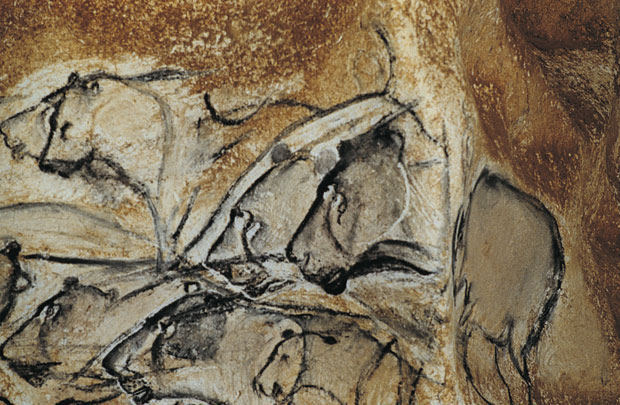I’ve long admired the films of Werner Herzog, so I was delighted to discover that his new film Cave of Forgotten Dreams, made in 3-D, is about the prehistoric paintings at Chauvet, in the Ardeche region of southeastern France. I learned a lot about the Chauvet cave about ten years ago, when I worked with Jean Clottes, the great French rock art expert who appears in Herzog’s film, on World Rock Art, a book published by the Getty Conservation Institute—which has long been involved in preserving rock art, first in Baja California and currently in southern Africa.

This scene in the Chauvet Cave depicts a pride of lions hunting big game. To the right, a rhinoceros seems to emerge from a recess in the wall. Photo by Jean Clottes. From the book World Rock Art (Getty Publications)
Working with Jean was a wonderful experience, and I could well imagine Chauvet’s myriad mysteries, presented through Herzog’s singular sensibility.
In the book Clottes recounts the discovery of Chauvet in 1994, when explorers probing deep caves in the remote Cirque d’Estre Gorge felt a mysterious draft coming from a passageway hidden behind a pile of stones. The passageway opened toward a large network of chambers some 25 feet below. The explorers lowered themselves down, and were astonished by what they saw. There were hearths, black with soot, that looked as if the fires had just been extinguished. There were calcite-covered bear skulls. And on the walls there were drawings and paintings—great friezes of mammoths and bears, cave lions and black horses, bison and reindeer and oxen, even a human figure, shown in complex scenes and, at times, in perspective. “Everything was so beautiful, so fresh,” they later wrote. “It was as if time had been abolished.”
Herzog’s mesmerizing film allows viewers to experience for themselves that astonishing moment, which altered our understanding of how the oldest known art was born. Lamp-lit cameras take us along dark narrow paths into the deep chamber where our Cro-Magnon ancestors inscribed their visions more than 30,000 years ago. “It is one of the greatest and most sensational discoveries in human culture,” says Herzog in an interview in Archaeology Magazine. “What is so fascinating is that it was preserved as a perfect time capsule…The quality of the art, which is from a time so far, so deep back in history, is stunning. It’s not that we have what people might call the primitive beginnings of painting and art. It is right there as if it had burst on the scene fully accomplished…the modern human soul somehow awakened.”
The motivations of those early painters remain mysterious. “Perhaps people came to the cavern to acquire the power of the great bears who hibernated here,” wrote Clottes in World Rock Art. In any case, he explains, the first human art “did not begin with crude sketches some thirty-five thousand years ago, as was previously thought, and then develop gradually until it attained the mastery of the art at Lascaux and other later Paleolithic caves. On the contrary, there were great artists in the bear cave at Chauvet, more than three hundred centuries ago.”

Rock art in Leliekloof, Eastern Cape, South Africa. Processions of people are typical of dancing scenes associated with altered states of consciousness. The sheep and dogs indicate that the paintings are less than 2,000 years old. Photo: Janette Deacon

Participants in a Getty Conservation Institute workshop on rock art site management planning record a rock art site in Mapungubwe National Park, South Africa, a World Heritage Site.




Comments on this post are now closed.